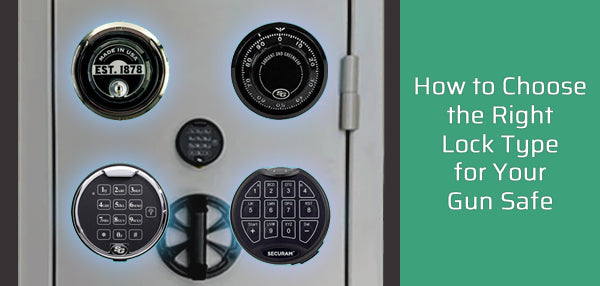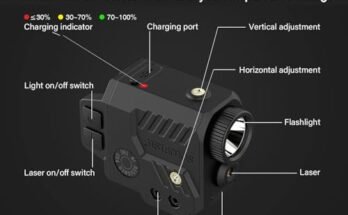You want to keep your pistol secure, but choosing the right safe can feel overwhelming. With so many options out there, how do you pick one that fits your needs perfectly?
This guide will help you understand exactly what to look for, so you can protect your firearm and keep it out of the wrong hands. By the time you finish reading, you’ll feel confident and ready to make the best choice for your safety and peace of mind.
Let’s get started.
Types Of Pistol Safes
Choosing the right pistol safe means understanding the main types. Each type offers unique features and security levels. Knowing the differences helps pick the best fit for your needs.
Types of pistol safes vary by locking mechanism and portability. Some use advanced technology, while others rely on traditional methods.
Biometric Safes
Biometric safes use fingerprint recognition for quick access. They offer high security and convenience. Only registered fingerprints can open the safe. These safes work well for quick firearm access in emergencies.
Electronic Keypad Safes
Electronic keypad safes require a code for entry. Users can change the code easily for added security. These safes provide fast access without keys. They need batteries to operate and may beep when opened.
Mechanical Dial Safes
Mechanical dial safes use a rotating dial to open. They do not need batteries or electricity. These safes are durable and reliable. Opening takes practice, but they offer solid security without tech.
Portable Vs. Fixed Safes
Portable safes are small and easy to move. They fit in bags or under seats for travel. Fixed safes attach to walls or floors. These provide more security and prevent theft. Choose based on where you plan to keep your pistol safe.

Key Features To Consider
Choosing the right pistol safe means understanding what features matter most. These features keep your firearms secure and protected. They also make sure you can access them quickly in an emergency. Focus on the safe’s locking system, resistance to fire and water, size, and how strong it is.
Locking Mechanisms
The locking mechanism is the heart of any pistol safe. Common types include key locks, combination dials, and electronic keypads. Electronic keypads offer quick access but need batteries. Mechanical locks never need power but can be slower to open. Choose a lock type that fits your comfort and security needs.
Fire And Water Resistance
Fire and water resistance can save your firearm from damage. Look for safes with fire ratings that show how long they protect against heat. Water resistance protects the safe in floods or from sprinklers. Check the safe’s rating to ensure it meets your protection needs.
Size And Capacity
Size matters for both your firearm and storage space. Pick a safe that fits your pistol with room for extra items like ammo or documents. Measure the space where you plan to keep the safe. A safe too big or too small can cause problems later.
Material And Build Quality
Strong materials keep the safe tough against break-ins. Steel is the most common and reliable option. Look for safes with thick steel walls and solid welds. The build quality affects how well the safe protects your pistol over time.
Placement And Installation
Choosing the right place and installing your pistol safe is very important. The safe must be secure but also easy to reach in emergencies. Placement affects how well your gun is protected from theft or misuse.
Think carefully about where to put your safe. The spot should keep the safe hidden from strangers but still accessible to you. The installation method also matters. A poorly installed safe can be easily stolen or tampered with.
Hidden Locations
Pick a place that is not obvious to others. Inside closets, under beds, or behind false panels work well. Avoid common spots like nightstands or drawers that burglars check first. Concealing the safe reduces the chance of theft.
Accessibility Vs. Security
Your safe should be easy for you to open quickly. But it must stay locked and secure from others. Balance is key. A safe placed too deep or locked too tightly can delay access in emergencies. Choose a location that fits your daily routine and safety needs.
Mounting Options
Secure the safe by mounting it to a wall, floor, or heavy furniture. Bolting the safe makes it hard to move or steal. Use strong screws and anchors for stability. Some safes come with mounting kits. Follow instructions carefully for best results.

Budget And Value
Choosing a pistol safe involves understanding your budget and the value you receive. Spending more does not always mean better security. It is important to find a safe that fits your price range and keeps your firearm secure. Think about how much you want to spend and what features are most important. Safety, size, and build quality matter. The goal is to get the best protection without overspending.
Balancing Cost And Security
Cheap safes may look good but often lack strong security. Strong locks, solid materials, and good construction raise costs. These features help stop theft or damage. Spend enough to protect your pistol well. Too low a price might mean weak protection. Decide what risks you face and how secure the safe must be. Balance price with quality for the best choice.
Warranty And Customer Support
A good warranty shows the maker trusts their product. It covers repairs or replacements if something goes wrong. Check how long the warranty lasts and what it covers. Customer support helps with questions or problems after purchase. Easy access to help means less stress. Choose a brand with clear warranty terms and helpful support. This adds value beyond the initial price.
Legal And Safety Considerations
Choosing the right pistol safe involves more than just size and price. Legal and safety concerns are very important. These rules protect you, your family, and others around you. Understanding these factors helps keep your firearms secure and legal.
Compliance With Local Laws
Every area has different laws about gun storage. Some places require safes with specific locks or features. Others demand safes to be bolted down or made of certain materials. Check your local laws before buying a safe. This step prevents legal trouble and fines.
Failing to follow these rules can lead to serious consequences. Police may seize your firearms. You might face charges for unsafe storage. Knowing the law means you stay safe and responsible.
Child Safety Features
Many pistol safes have special locks to keep children away. These include biometric scanners, combination locks, or keys. Choose a safe that fits your family’s needs. A safe with quick access for adults but secure from kids is ideal.
Child safety is crucial. Unsecured guns can cause accidents or injuries. A safe with childproof features helps prevent these risks. It gives peace of mind in homes with young children.
Maintenance And Upkeep
Proper maintenance keeps your pistol safe working well and secure. Regular care prevents problems and extends the safe’s life. It also ensures quick access when needed. Focus on three key areas: battery replacement, regular testing, and cleaning.
Battery Replacement
Most pistol safes use batteries to power locks. Replace batteries before they die to avoid lockouts. Check battery life every few months. Use fresh, high-quality batteries for best results. Remove old batteries to prevent leaks and damage.
Regular Testing
Test your safe often to confirm it opens smoothly. Try the lock code or key every month. This practice ensures the mechanism works in emergencies. Do not wait for a problem to find out the safe is stuck.
Cleaning Tips
Keep the safe clean inside and out. Use a soft cloth to wipe dust and dirt. Avoid harsh chemicals that can harm surfaces or lock parts. Vacuum inside the safe to remove debris. Clean hinges and locking parts gently to maintain smooth function.

Frequently Asked Questions
What Size Pistol Safe Do I Need?
Choose a pistol safe that fits your handgun comfortably. Consider extra space for additional pistols or accessories. Measure your pistol dimensions before buying to ensure a proper fit.
How Secure Should A Pistol Safe Be?
A pistol safe should have solid steel construction and a reliable locking system. Look for safes with tamper-proof features and fire resistance for added security.
What Locking Mechanism Is Best For Pistol Safes?
Electronic keypads offer quick access and are user-friendly. Biometric locks provide enhanced security but may cost more. Choose based on your convenience and security needs.
Are Fireproof Pistol Safes Necessary?
Fireproof safes protect your firearms from damage during a fire. If you live in fire-prone areas, investing in a fire-resistant safe is wise for added safety.
Conclusion
Choosing the right pistol safe protects your firearm and family. Focus on size, lock type, and build quality. Think about where you will keep the safe. Ease of access matters, but so does security. A good safe balances safety with convenience.
Take your time to compare features and prices. Your peace of mind depends on a smart choice. Keep your pistol safe from theft and accidents. Safety starts with the right storage solution.



